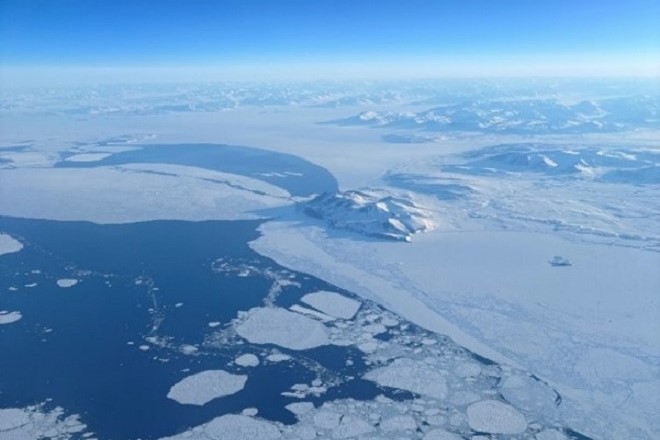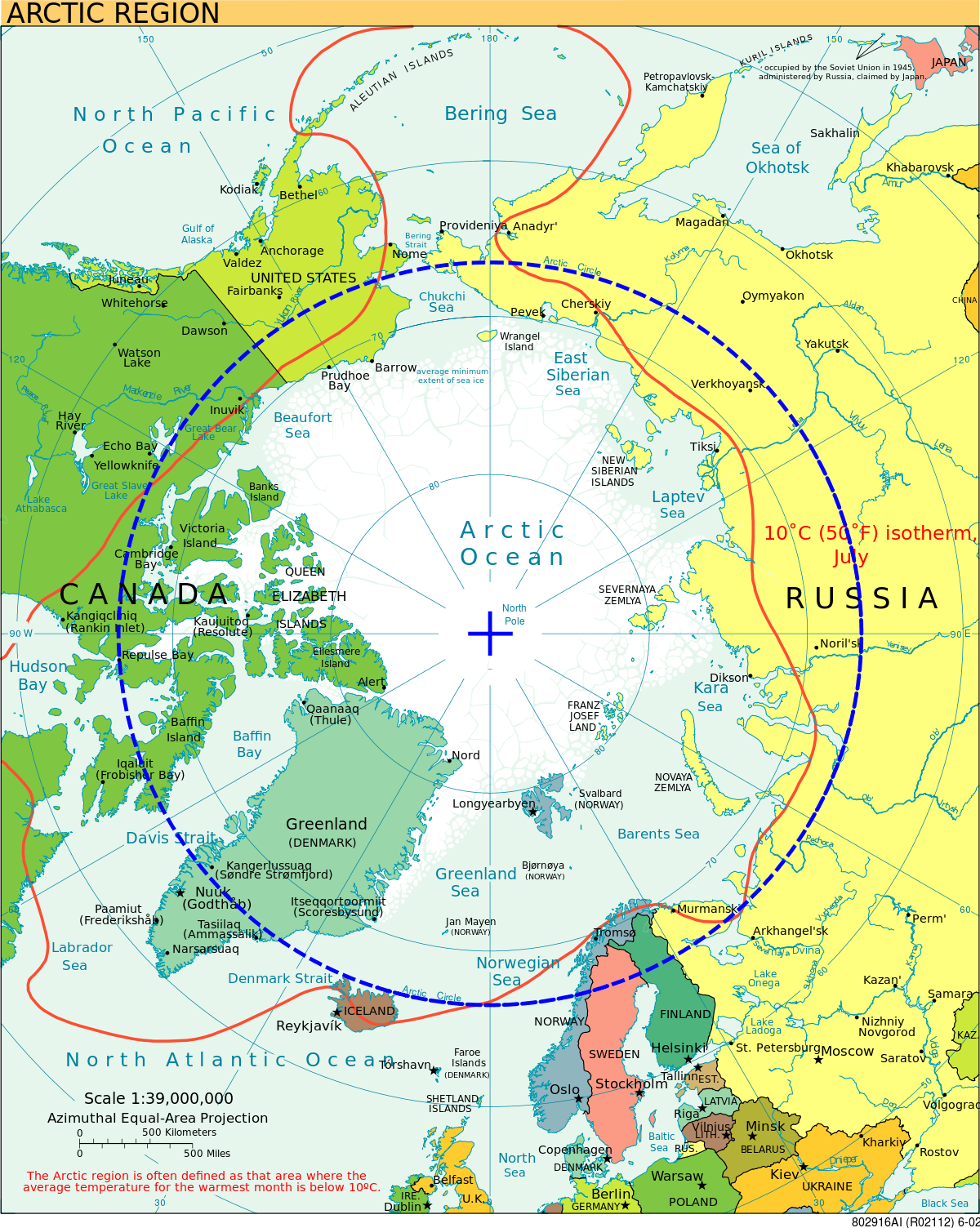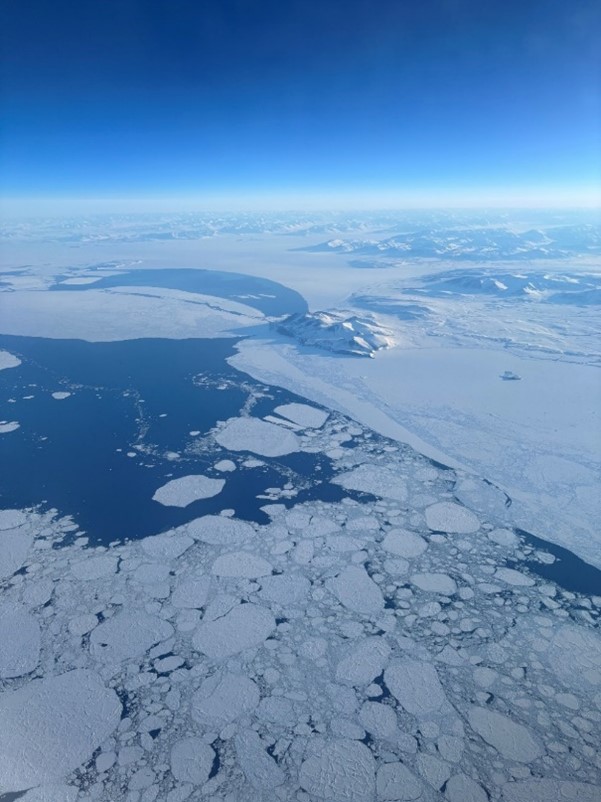JH Explorer over Greenland: Natural resources for the future
With predictions for the consumption of energy, metals and food over the next 25 years overwhelming those from all previous periods, Daniel Sullivan, Head of Global Natural Resources, outlines an approach for achieving long-term success in the natural resources sector.

7 minute read
Key takeaways:
- A recent flight over the Greenland ice sheet serves as a reminder of the earth’s sensitivity and global environmental challenges ahead.
- Global trends such as geopolitical realignment, the push for a sustainable future, and population growth emphasise the need for resilient natural resource management and infrastructure development to support growth.
- Preparing for a future of electrification and a shift towards low-carbon economies, leading to an increased demand for critical metals like copper and lithium, highlights the importance of environmental, social, and governance (ESG) considerations.
I recently took a work flight from London to Japan, and being a value buyer, I found a flight at 35% discount. It was a bit longer and was to fly across the arctic circle, but I thought I had a chance of seeing something interesting. Flying over Greenland was spectacular and a great reminder of the earth’s sensitivity to climate change.

Arctic region1
The Greenland ice sheet which covers 80% of the land is incredibly significant when it comes to global warming, holding enough ice to raise sea levels by over 7 metres if it were all to melt.2 Yes, seven metres. The deterioration of the Greenland ice sheet heralds big trouble for the world; the late 19th century Welsh safety check for deadly carbon monoxide of the ‘canary in the coal mine’3 brought to the 21st century, if you will. Worldwide, many large cities are very close to sea level and very vulnerable to sea level rises. These include Bangkok, Amsterdam, Ho Chi Minh City, Cardiff, New Orleans, Manilla and London.4
My flight took me on an incredible route, laden with a diverse history of natural resources. It flew over England; the birthplace of the Industrial Revolution; Scotland with its North Sea oil and gas fields; the fishing industry of the Faroe Islands; and finally, Iceland, with its geothermal power, aluminium smelting, and fishing. The ice shelf of Greenland is an immense natural resource, and its loss will cause a rise in global sea levels. Many cities will pay the price if we don’t prevent global warming from destroying it.

Aerial view of Greenland. Source: Daniel Sullivan
Coming over into Inuit Nunangat5 we have the deep history of the Northwest Passage, Baffin Bay, the Hudson Bay Trading Company, and the gold and diamond mines. Alaska, purchased by the United States for $7.2 million in 1867, holds some of the richest discoveries ever including the Klondike Gold Rush, Red Dog zinc mine, Prudhoe Bay the largest oil field in North America (at 25 million barrels), Sakhalin LNG, the Japanese nuclear power industry, and finally landing in Tokyo, the largest city on Earth with over 37 million people.
The Janus Henderson Global Natural Resources team that I lead has a core belief; that a global investment approach focused on high-quality assets combined with specialist investment and industry expertise is the key to superior long-term investment returns in the natural resources sector. In positioning the strategy for clients, our investment process considers the existing and future operating cost position vs competitors, quality of management and assets, competitive advantages, financial leverage, favourable environmental, social and governance (“ESG”) characteristics, growth optionality and valuation. The focus of the strategy is where the best risk adjusted return for the company is supported by catalysts and confidence in the delivery of the investment thesis by management.
ESG plays an integral part of the investment process of our team. Based on the team’s collective experience of 118 years analysing and investing in natural resource stocks, we believe that there are four material responsible investment drivers over the long-term. Only with strong corporate governance can our companies achieve long term business success. Workplace health and safety is a critical human right6. Only by protecting and enhancing a company’s reputation and “social licence to operate and grow” can a company mitigate permit loss or operating restrictions.
At a global level, climate change is a critical issue for society and has particular significance for natural resource assets as society moves to a low-carbon economy. These issues include transitional risks and opportunities and physical impacts of extreme weather events.
All these considerations lead us to construct client portfolios with a diversified exposure to many high-quality resource assets and management teams. The focus is on companies positioning for growth with a lifecycle of new development. Low-cost producers can manage cyclical-low growth faster than their competitors. An attractive valuation set-up, particularly amongst mid-capitalisation US$1-6bn market cap companies is exposed across five big industries with exposures to metals, gold, uranium, oil & gas, and agriculture.
Clients frequently ask us what Janus Henderson thinks about what’s going on in the world around us and how that impacts the markets. We see huge trends that may impact our investments, including geopolitical realignment, the worldwide push for a sustainable future, and the issues of a decade of limited new projects now coinciding with a return of the cost of capital and project cost inflation.
The world still has decades of strong growth ahead. By 2050, population growth is estimated to increase from 8 billion toward 10 billion. Urban areas look set to grow from 4.3 billion (55% of the worlds’ population) to 7 billion people (70% of the world population).7 1 in 3 people still lack basic services. As we see the population growth and higher living standards will need increased productivity from constrained resources (metals, energy, land, water, fertiliser) to satisfy demand.
We have seen many new world conflicts and supply disruptions leading to decentralisation of supply chains in critical resources. In response to Russia invading the Ukraine, we have seen Europe shut off Russian gas, and vast sums being spent on the war. The US wants to cut dependency on technology from China. Houthi’s have impacted Red Sea shipping. Trade and security tensions remain very high.
This is not a decade to be overwhelmed by fear or invest too defensively. Inflation and interest rates have soared from the falling rates of the past 30 years and abnormal ultra-low rates of the past 10 years. In the next 25 years, the world wants to lower greenhouse gas emissions and manage a demographic shift from many established economies to younger faster growing countries. The scale of consumption of energy, metals, and food over the next 25 years overwhelms all previous periods. We need to plan and build resilient natural resources production and cities to have any prospect of managing these complex challenges.
My thoughts coupled with the amazing views from my seat reminded me about the key role natural resources plays in the world and why I am so passionate about investing in this diverse area. Not forgetting, this is also an asset class that offers strong returns and growth potential, portfolio diversification and can act as an inflation hedge.
There are a myriad of exciting and attractive investment opportunities across resources stocks. Mining and metals are fundamental to human livelihoods in the modern world – here, we expect to see the greatest uplift in demand particularly in the electrification, critical metals of copper and lithium as we move towards a more sustainable world for all.
1CIA World Fact Book, Arctic Circle, 15 May 2024
2Anne M. Stark, Greenland melted recently, shows high risk of sea level rise today, 20 July 2023
3Kat Eschner, What Happened to the Canary in the Coal Mine? The Story of How the Real-Life Animal Helper Became Just a Metaphor, 7 March 2024
4Martina Igini, Sea Level Rise Projections: 10 Cities at Risk of Flooding, 4 June 2022
5Indigenous Peoples Atlas of Canada, Inuit Nunangat, 2024
6United Nations, Universal Declaration of Humans Rights (Article 23), 2024
7Bruno Venditti, This chart shows the impact rising urbanization will have on the world, 26 April 2022
JHI
IMPORTANT INFORMATION
Commodities (such as oil, metals and agricultural products) and commodity-linked securities are subject to greater volatility and risk and may not be appropriate for all investors. Commodities are speculative and may be affected by factors including market movements, economic and political developments, supply and demand disruptions, weather, disease and embargoes.
Natural resources industries can be significantly affected by changes in natural resource supply and demand, energy and commodity prices, political and economic developments, environmental incidents, energy conservation and exploration projects.
Sustainable or Environmental, Social and Governance (ESG) investing considers factors beyond traditional financial analysis. This may limit available investments and cause performance and exposures to differ from, and potentially be more concentrated in certain areas than the broader market.
There is no guarantee that past trends will continue, or forecasts will be realised.
References made to individual securities do not constitute a recommendation to buy, sell or hold any security, investment strategy or market sector, and should not be assumed to be profitable. Janus Henderson Investors, its affiliated advisor, or its employees, may have a position in the securities mentioned.
All opinions and estimates in this information are subject to change without notice and are the views of the author at the time of publication. Janus Henderson is not under any obligation to update this information to the extent that it is or becomes out of date or incorrect. The information herein shall not in any way constitute advice or an invitation to invest. It is solely for information purposes and subject to change without notice. This information does not purport to be a comprehensive statement or description of any markets or securities referred to within. Any references to individual securities do not constitute a securities recommendation. Past performance is not indicative of future performance. The value of an investment and the income from it can fall as well as rise and you may not get back the amount originally invested.
Whilst Janus Henderson believe that the information is correct at the date of publication, no warranty or representation is given to this effect and no responsibility can be accepted by Janus Henderson to any end users for any action taken on the basis of this information.


